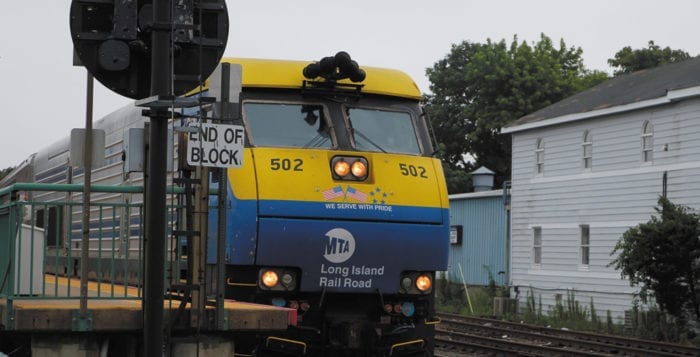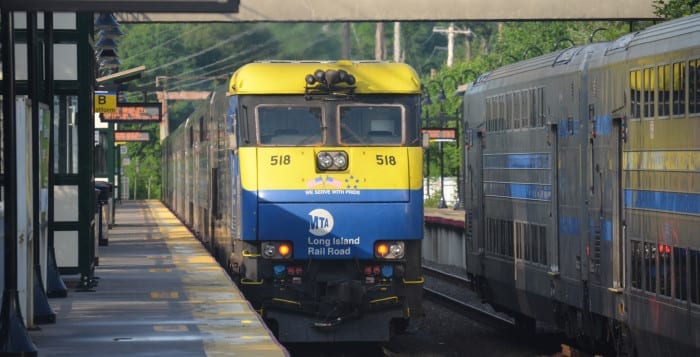Representatives from the national environmental advocacy group Sierra Club along with local representatives are calling for the electrification of Long Island’s transportation, especially its trains.
“This is a challenge, but we need to accept it.” —Charles Bevington
On Dec. 9, the Sierra Club was joined by local representatives at a press conference at the Long Island Rail Road’s Stony Brook train station. The event was part of the Get Set, Go Green! relay, where people from across the state, including Buffalo, Rochester, Lower Hudson Valley, New York City and Plattsburgh, are traveling to Albany on multiple modes of low-carbon transportation. The goal is to deliver a petition signed by thousands of New Yorkers to Gov. Andrew Cuomo (D) by Dec. 12.
The Dec. 9 event included a send-off for relayer Edgar Cid, 25, of Lindenhurst, who was set to take the 1:19 p.m. train from Stony Brook to Penn Station to deliver petitions to the next relayer in New York City. Cid said he was happy to participate as he realizes the importance of moving toward more electric-based transportation on the Island, including trains.
Charles Bevington, chair of Sierra Club Long Island Group, said so far more than 7,500 signatures have been collected and the hope is to get to 10,000.
“This is a challenge, but we need to accept it,” Bevington said. “We need to move forward on it.”

State Assemblyman Steve Englebright (D-Setauket), Brookhaven Town Supervisor Ed Romaine (R), Port Jefferson Village trustee Bruce Miller and Mothers Out Front volunteer leader Billii Roberti, of Huntington, joined Bevington and other environmental activists to support the relay.
The petition urges Cuomo to adopt a statewide target to reduce emissions 55 percent from transportation by 2035 in his 2020 State of the State address. According to Englebright, the largest amount of state greenhouse gas emissions, 36 percent, comes from transportation. He said the governor recently signed the Climate Leadership and Community Protection Act, which sets a statewide goal to reach net zero greenhouse gas emissions by 2050. He added that for the state to reach the climate goals detailed in the act, a reduction of emissions must begin now.
The assemblyman said the frequency of hurricanes, invasion of species harmful to our ecosystems and warming waters that have destroyed lobsters point to being “in the midst already of a climate crisis.”
The act sets a goal for 70 percent of the state’s electricity to come from renewable energy within 11 years and 100 percent of the state’s electricity supply must be emissions free by 2040. Englebright said he is concerned that the LIRR is in the process of replacing its old diesel fleet with new diesel engines.
“That’s not only inconsistent with the new law, it is incoherent,” he said. “We have talked for years about electrifying the north line of the rail road, making it more efficient, making it possible to pull more cars off the roads and to use mass transit. This is an investment that we need to make into electrification, not into [20th]-century diesel locomotives.”
Three train branches transverse Brookhaven — Port Jefferson, Ronkonkoma (including Greenport) and Montauk. Romaine said each of the branches depends on diesel at some point, and he and the Town Board have advocated converting to electrification since he entered office.
“The MTA is not spending the money that it should be spending on electrifying these lines,” he said. “Imagine less diesel flowing into our atmosphere because our lines are electrified.”
“It’s long overdue. We’ve relied on diesel since forever it seems like, except for the first [steam] locomotive, but it’s a hundred year old technology.” — Ed Romaine
Miller said he knows many from Calverton to Greenlawn commute by car to the Ronkonkoma line.
“This is completely environmentally inappropriate and unsustainable,” he said.
In addition to the electrification of trains, Roberti called for school districts and bus companies to transition to all-electric fleets by 2030 and asked the governor and state legislators to assist them with funding.
The activist cited health concerns from diesel fuel emissions including increased cancer-causing soot and incidences of pneumonia and asthma attacks.
For years, officials have pleaded for the electrification of the LIRR branches that require diesel. State Sen. Jim Gaughran (D-Northport) said in an email that he hears complaints about poor and insufficient service and realizes the environmental benefits of electrification.
“Electrification, including of the Oyster Bay and Port Jefferson lines, would greatly improve service and provide riders desperately needed relief,” Gaughran said. “It is also tremendously beneficial for our environment. I am not optimistic the MTA is taking the urgency of electrification seriously and I urge them to seriously consider electrification.”
Cold Spring Harbor Laboratory officials recognize the environmental as well as other benefits of electrification of the LIRR.
“The proposed improvements to the LIRR, including purchases of new trains, electrification of the Port Jefferson tracks and the addition of a third track between Floral Park and Hicksville will all serve to increase the frequency of trains and the efficient use of clean energy for transportation,” said Bruce Stillman, CSHL president and CEO. “Cold Spring Harbor Laboratory has a close relationship with Stony Brook University and improving rail transportation between our two institutions will help to advance science and education.”
Romaine said the rough estimate for electrification of the railroad was about $18 million a mile. There will be a need for a new rail yard, which the town already has plans in place, and electrification stations along the branches to ensure the rails are electrified along with other signal and communications upgrades.
“It’s an expensive project,” he said. “It’s long overdue. We’ve relied on diesel since forever it seems like, except for the first [steam] locomotive, but it’s a hundred year old technology.”
Jane Fasullo, former chair of the local Sierra Club, said the offset of the costs will be improved health, and in the long term as the cost of the infrastructure of wind and solar goes down, the cost of electrifying vehicles will go down.
“It’s one of those things where you put money into it today to save a lot of money later on,” Fasullo said.
In an email statement, LIRR spokesman Aaron Donovan said the railroad shares the Sierra Club’s concern.
“We recognize our service is one of the most significant ways that Long Islanders can lower their carbon footprint, and we strive to continuously improve our service delivery,” Donovan said. “Public transportation, even when powered by diesel, is greener per passenger mile than private, single-occupancy electric vehicles.”
A copy of the petition can be found at sc.org/55×35.









